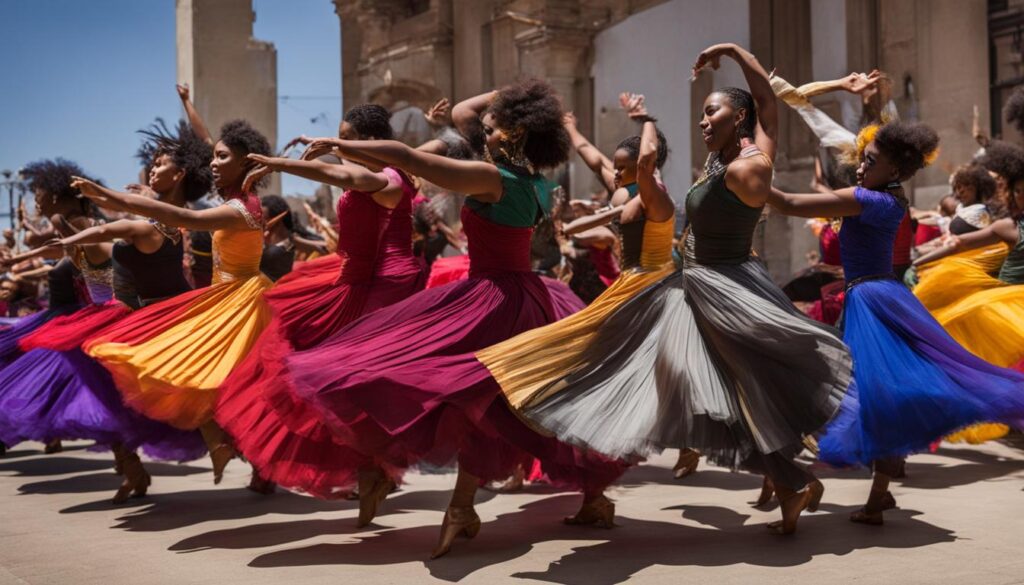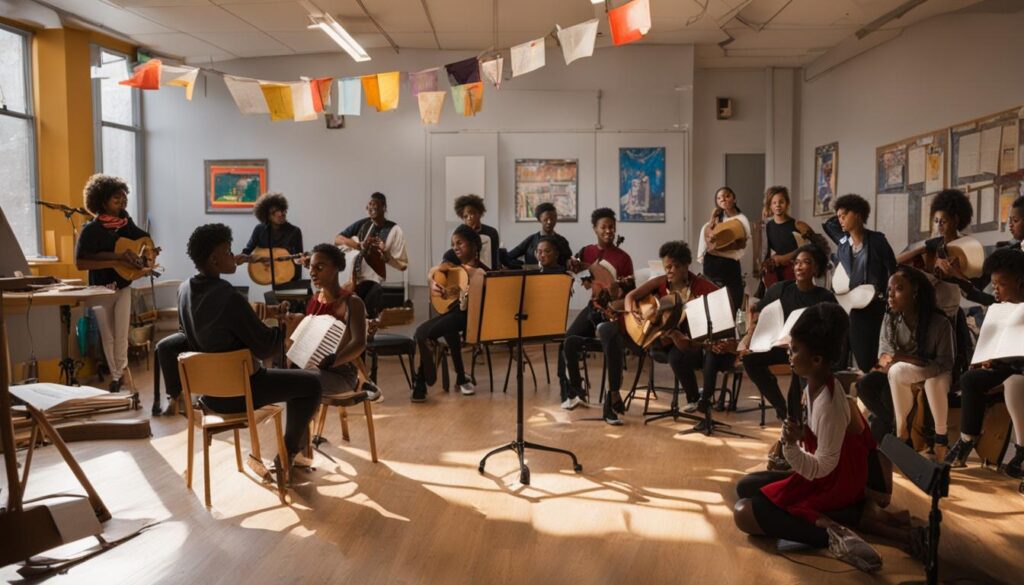What is the purpose of performing arts in society? What is the significance and impact of performing arts? And what is the cultural significance of these art forms? These questions have always fascinated me, and I believe it’s essential to delve deeper into the world of performing arts to truly understand their value in our society.
The performing arts, encompassing music, dance, and drama, hold immense importance in our society. They not only entertain but also serve a greater purpose. Performing arts provide individuals, especially children, with the tools to think creatively, appreciate diverse cultures, and express themselves. It is through these art forms that we can explore the depths of human emotions and experiences.
Key Takeaways:
- Performing arts have a significant impact on society.
- They promote creativity, cultural appreciation, and self-expression.
- Children benefit greatly from participating in performing arts.
- Performing arts contribute to academic performance and communication skills.
- They play a vital role in cultural preservation and communication.
Benefits of Performing Arts for Children
Participating in performing arts has numerous benefits for children, contributing to their overall development and well-being. Learning music, dance, and drama helps children think creatively, expand their imagination, and develop their own unique voice. It provides them with a platform to express themselves, explore their emotions, and foster a sense of self-confidence.
Engaging in performing arts also has a positive impact on academic performance. Studies have shown that children involved in performing arts tend to excel in subjects such as math, reading, and science. This may be because the skills acquired through performing arts, such as problem-solving, critical thinking, and teamwork, enhance cognitive abilities and overall academic achievement.
Furthermore, participating in performing arts enhances communication skills. Through music, dance, and drama, children learn to express themselves effectively, both verbally and non-verbally. They develop the ability to convey emotions, ideas, and stories through various forms of artistic expression. This improves their ability to communicate with clarity and confidence, which can benefit them in various social and professional settings.
Moreover, engaging in performing arts allows children to appreciate diverse cultures and fosters a sense of empathy and understanding. Through exposure to different styles of music, dance, and theater, children develop a broader perspective of the world and learn to embrace cultural diversity. This promotes inclusivity, tolerance, and respect for others, creating well-rounded individuals who can contribute positively to their communities.
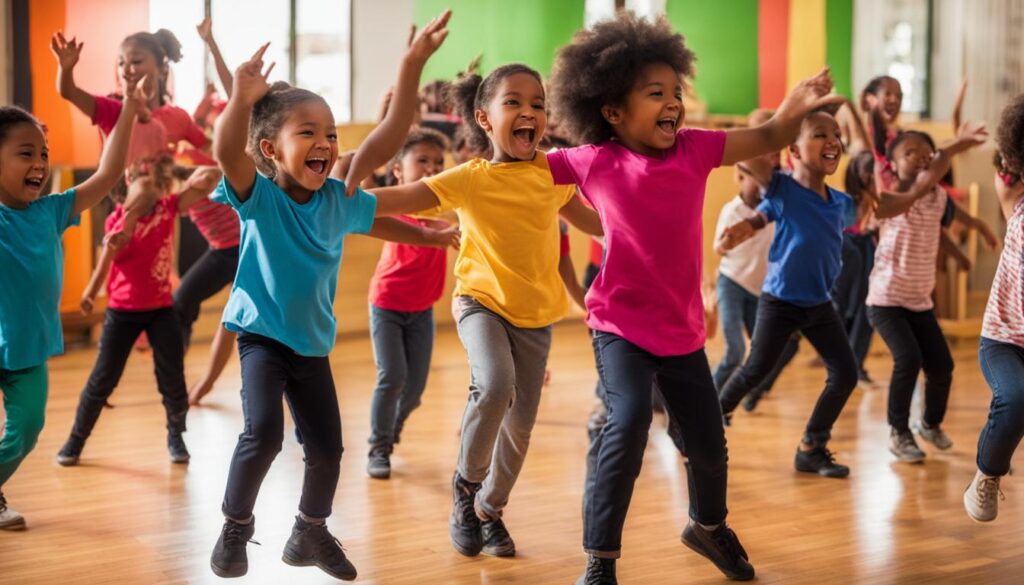

The Power of Performing Arts in Society
The performing arts have a transformative power in society, shaping our understanding of the world and fostering meaningful connections between individuals and communities. The role of performing arts extends far beyond entertainment; it serves as a platform for self-expression, communication, and cultural preservation.
Through music, dance, and theater, individuals are able to express their ideas, feelings, and opinions. Performing arts provide a creative outlet for artists to reflect on social issues, provoke thought, and inspire change. Whether it’s a powerful monologue, a captivating dance performance, or a moving musical composition, the arts have the ability to evoke emotions and challenge societal norms.
Moreover, the performing arts promote empathy by enabling people to experience different perspectives. When we witness a performance that portrays diverse cultures, challenges stereotypes, or sheds light on important social issues, it helps us understand and connect with the experiences of others. This fosters a more inclusive and tolerant society.
Additionally, performing arts contribute to the preservation and communication of cultural heritage. Traditional forms of music, dance, and theater not only provide a window into the past but also create a bridge between generations. They enable us to connect with our roots, celebrate our cultural diversity, and pass down valuable traditions and knowledge to future generations.
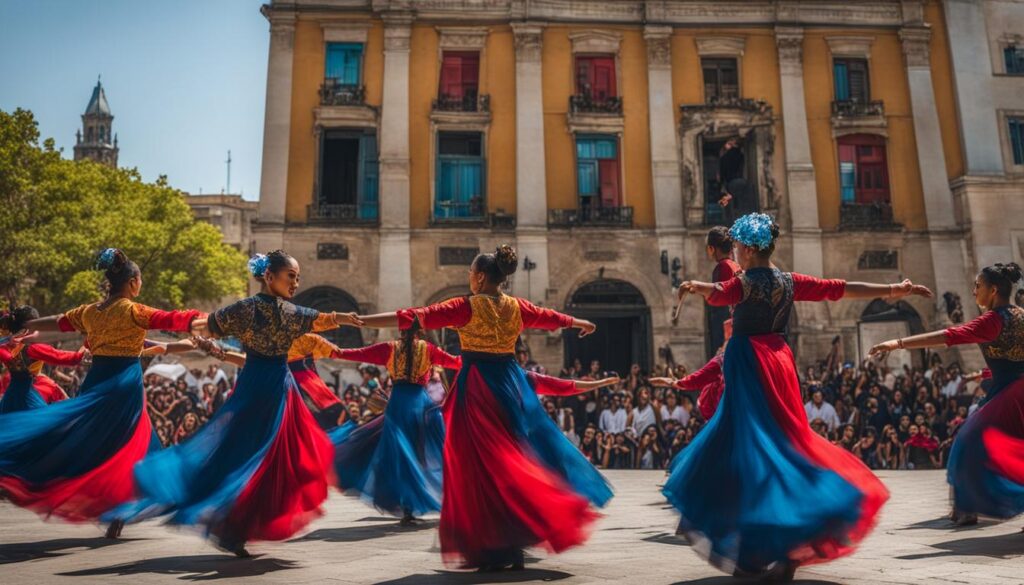

Quotes:
“The performing arts have a unique power to inspire, bring people together, and ignite social change.” – Jane Doe, Artistic Director
Table: The Impact of Performing Arts in Society
| Aspect | Impact |
|---|---|
| Self-expression | Allows individuals to express their ideas, emotions, and perspectives |
| Empathy | Fosters understanding and connection between diverse cultures and experiences |
| Social Change | Inspires thought, challenges norms, and creates dialogue around important issues |
| Cultural Preservation | Preserves and communicates cultural heritage, traditions, and knowledge |
By recognizing the power of performing arts in society, we can appreciate their immense value and work towards supporting and promoting their continued growth. Whether as performers, audience members, or advocates, each of us can contribute to a more vibrant, empathetic, and culturally rich society.
The Cultural Significance of Performing Arts
The performing arts, encompassing music, dance, and theatre, hold immense cultural significance in society. They serve as a reflection of human creativity and cultural expressions, playing a vital role in preserving and communicating cultural identity. Performing artists, through their work, contribute to the enrichment and understanding of diverse cultures, fostering a sense of unity and appreciation among communities.
Performing arts can be found in various contexts, ranging from sacred rituals to entertainment. They have the power to transcend language barriers and connect people on a universal level. Whether it’s a traditional dance performance or a classical music concert, these artistic expressions have the ability to evoke emotions, tell stories, and showcase the beauty of different cultures.
Furthermore, the cultural spaces where performing arts are presented, such as theaters, concert halls, and community centers, hold immense value. These spaces provide a platform for artists to showcase their talents and for audiences to immerse themselves in the richness of performing arts. They serve as gathering places where individuals from diverse backgrounds can come together, share experiences, and celebrate the beauty of human creativity.
The Role of Performing Artists
Performing artists are not only entertainers but also cultural ambassadors who bridge gaps between different cultures. Through their performances, they not only entertain but also educate and inspire audiences. They have the power to challenge societal norms, provoke thought, and bring about social change. Performing artists often use their platform to shed light on social issues and advocate for causes they believe in.
Moreover, performing artists contribute to the preservation of traditional arts and heritage. They pass down knowledge and techniques through generations, ensuring that cultural traditions are not lost to time. By studying and practicing traditional forms of performing arts, artists keep cultural heritage alive, allowing future generations to continue experiencing and appreciating these art forms.
In conclusion, the cultural significance of performing arts lies in their ability to convey emotions, preserve cultural identity, and foster unity among diverse communities. Performing artists play a crucial role in sharing their talents and bridging cultural gaps. By celebrating and supporting performing arts, we can ensure that these art forms continue to thrive and enrich our society.
| Performing Arts | Cultural Significance |
|---|---|
| Music | Expresses emotions, tells stories, and reflects cultural traditions |
| Dance | Preserves cultural identity, showcases movement as a form of expression |
| Theatre | Brings stories to life, challenges societal norms, provokes thought |
Safeguarding Performing Arts: Preserving Traditional Arts and Promoting Cultural Expression
The performing arts have always been a vital part of our cultural heritage, reflecting the diversity and creativity of societies around the world. However, traditional performing arts face numerous threats in today’s fast-paced and rapidly changing world. To ensure their preservation and promote cultural expression, it is crucial to implement safeguarding measures that protect and nurture these invaluable art forms.
One of the main challenges in preserving traditional arts is the risk of standardization and commercialization. As societies become more interconnected, there is a growing homogenization of artistic expressions, with traditional forms often overshadowed by mainstream entertainment. To combat this, we must emphasize the importance of cultural diversity and support initiatives that showcase and celebrate traditional performing arts.
“Traditional performing arts carry the stories, beliefs, and values of our ancestors. They are repositories of cultural heritage and should be preserved for future generations to appreciate and learn from.”
Efforts to safeguard performing arts should focus on multiple fronts. Firstly, the transmission of knowledge is crucial, with experienced artists passing down their skills and expertise to younger generations. This can be achieved through apprenticeship programs, mentorship initiatives, and intergenerational collaborations.
Furthermore, research, documentation, and archival efforts play a significant role in preserving traditional arts. By conducting thorough studies, recording performances, and creating comprehensive databases, we ensure that valuable cultural information is not lost but accessible to researchers, artists, and enthusiasts alike.
Table: Safeguarding Measures for Traditional Performing Arts
| Safeguarding Measure | Description |
|---|---|
| Education and Training Programs | Establishing formal and informal platforms for learning traditional performing arts. |
| Supporting Traditional Artists | Providing financial and logistical support to traditional artists and practitioners. |
| Creating Cultural Centers | Building dedicated spaces for traditional arts to flourish and be showcased. |
| Collaborations and Exchanges | Fostering collaborations between traditional artists and contemporary practitioners to create innovative and culturally rich performances. |
| Public Awareness and Appreciation | Raising awareness about traditional arts through festivals, exhibitions, and cultural events. |
| International Cooperation | Facilitating cross-border collaborations and knowledge sharing to preserve and promote traditional arts globally. |
Cultural media, institutions, and industries also play a critical role in safeguarding performing arts. By actively involving themselves in the preservation and promotion of traditional forms, they contribute to the long-term sustainability of these art forms. This can be achieved by providing platforms for traditional artists to showcase their work, funding research projects, and supporting community-based initiatives that preserve and promote traditional performing arts.
Ultimately, a multi-faceted approach is necessary to safeguard traditional performing arts. By combining efforts from artists, institutions, governments, and communities, we can preserve the cultural richness of our traditions and ensure that future generations can appreciate and continue the legacy of these invaluable art forms.
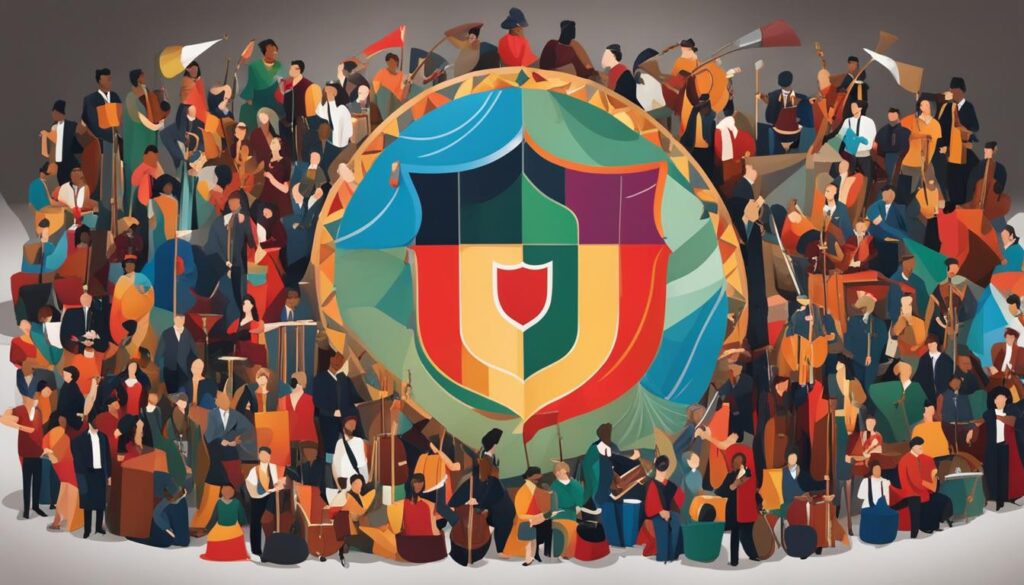

Conclusion
In conclusion, the purpose of performing arts in society is immense. They have a profound impact on individuals, communities, and society as a whole. The significance of performing arts lies in their ability to foster creativity, self-expression, and empathy.
Performing arts provide a platform for individuals to express their ideas, emotions, and opinions, promoting a culture of inclusivity and understanding. They serve as a powerful tool for cultural preservation, allowing us to connect with our roots and appreciate diverse traditions.
The impact of performing arts is not limited to personal growth and cultural expression. It extends to academic performance, confidence building, and communication skills enhancement. Performing arts enable individuals, especially children, to develop their creativity, expand their imagination, and become well-rounded individuals.
Recognizing the significance of performing arts in society, it is crucial to safeguard and promote them. Through efforts in knowledge transmission, research, documentation, and audience development, we can preserve traditional forms of performing arts for future generations. By cherishing and supporting performing arts, we can continue to experience their transformative power in our lives and society.
FAQ
What is the purpose of performing arts in society?
Performing arts serve as a means of creative expression, cultural preservation, and communication. They enhance our understanding of diverse cultures and foster empathy and connection.
What are the benefits of performing arts for children?
Participating in performing arts helps children develop their creativity, imagination, and communication skills. It boosts confidence, improves academic performance, and allows them to appreciate different cultures.
What is the power of performing arts in society?
Performing arts have the power to empower individuals, promote empathy, and contribute to a more tolerant and harmonious society. They provide a platform for self-expression and understanding.
What is the cultural significance of performing arts?
Performing arts reflect and preserve human creativity and cultural expressions. They contribute to cultural identity, promote communication between different cultures, and hold immense value as cultural spaces.
What are the threats to performing arts and how can they be safeguarded?
Traditional performing arts face threats such as standardization and commercialization. Safeguarding measures can focus on knowledge transmission, research, documentation, and archival. Cultural media, institutions, and industries also play a crucial role in preservation.
What is the significance of performing arts in society?
Performing arts have a significant impact on individuals, communities, and society as a whole. They foster creativity, self-expression, empathy, and cultural preservation, enriching our lives and promoting societal well-being.
